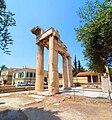
The agora was a central public space in ancient Greek city-states. It is the best representation of a city-state's response to accommodate the social and political order of the polis. The literal meaning of the word "agora" is "gathering place" or "assembly". The agora was the center of the athletic, artistic, business, social, spiritual, and political life in the city. The Ancient Agora of Athens is the best-known example.

The ancient Agora of Athens is the best-known example of an ancient Greek agora, located to the northwest of the Acropolis and bounded on the south by the hill of the Areopagus and on the west by the hill known as the Agoraios Kolonos, also called Market Hill. The Agora's initial use was for a commercial, assembly, or residential gathering place.
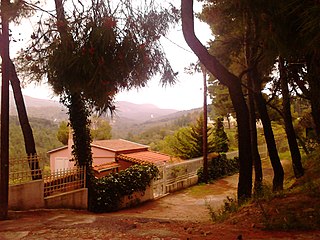
Acharnae or Acharnai was a deme of ancient Athens. It was part of the phyle Oineis.

The Arch of Hadrian, most commonly known in Greek as Hadrian's Gate, is a monumental gateway resembling—in some respects—a Roman triumphal arch. It spanned an ancient road from the center of Athens, Greece, to the complex of structures on the eastern side of the city that included the Temple of Olympian Zeus.
Greece in the Roman era describes the Roman conquest of the territory of the modern nation-state of Greece as well as that of the Greek people and the areas they inhabited and ruled historically. It covers the periods when Greece was dominated first by the Roman Republic and then by the Roman Empire. In the history of Greece, the Roman era began with the Corinthian defeat in the Battle of Corinth in 146 BC. However, before the Achaean War, the Roman Republic had been steadily gaining control of mainland Greece by defeating the Kingdom of Macedon in a series of conflicts known as the Macedonian Wars. The Fourth Macedonian War ended at the Battle of Pydna in 148 BC with the defeat of the Macedonian royal pretender Andriscus.

The Athena Promachos was a colossal bronze statue of Athena sculpted by Pheidias, which stood between the Propylaea and the Parthenon on the Acropolis of Athens. Athena was the tutelary deity of Athens and the goddess of wisdom and warriors. Pheidias also sculpted two other figures of Athena on the Acropolis, the huge gold and ivory ("chryselephantine") cult image of Athena Parthenos in the Parthenon and the Lemnian Athena.
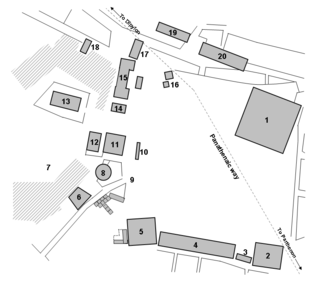
Stoa Basileios, meaning Royal Stoa, was a Doric stoa in the northwestern corner of the Athenian Agora, which was built in the 6th century BC, substantially altered in the 5th century BC, and then carefully preserved until the mid-second century AD. It is among the smallest known Greek stoas, but had great symbolic significance as the seat of the Athenian King Archon, repository of Athens' laws, and site of "the stone" on which incoming magistrates swore their oath of office.

The Temple of Ares was a Doric hexastyle peripteral temple dedicated to Ares, located in the northern part of the Ancient Agora of Athens. Fragments from the temple found throughout the Agora enable a full, if tentative, reconstruction of the temple's appearance and sculptural programme. The temple had a large altar to the east and was surrounded by statues. A terrace to the north looked down on the Panathenaic Way. The northwest corner of the temple overlays one of the best-preserved Mycenaean tombs in the Agora, which was in use from ca. 1450-1000 BC.

The city of Athens during the classical period of ancient Greece was the major urban centre of the notable polis (city-state) of the same name, located in Attica, Greece, leading the Delian League in the Peloponnesian War against Sparta and the Peloponnesian League. Athenian democracy was established in 508 BC under Cleisthenes following the tyranny of Isagoras. This system remained remarkably stable, and with a few brief interruptions remained in place for 180 years, until 322 BC. The peak of Athenian hegemony was achieved in the 440s to 430s BC, known as the Age of Pericles.
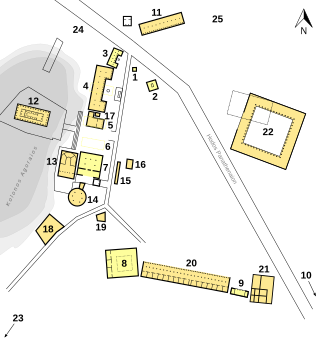
The Temple of Apollo Patroos is a small ruined temple on the west side of the Ancient Agora of Athens. The original temple was an apsidal structure, built in the mid-sixth century BC and destroyed in 480/79 BC. The area probably remained sacred to Apollo. A new hexastyle ionic temple was built ca. 306-300 BC, which has an unusual L-shaped floor plan. Some fragments from the sculptural decoration of this structure survive. The colossal cult statue, by Euphranor, has also been recovered.

The Philopappos Monument is an ancient Greek mausoleum and monument dedicated to Gaius Julius Antiochus Epiphanes Philopappos or Philopappus,, a prince from the Kingdom of Commagene. It is located on Mouseion Hill in Athens, Greece, southwest of the Acropolis.

The Roman Agora at Athens is located to the north of the Acropolis and to the east of the Ancient Agora.
The 'Hiera Orgas', meaning ‘sacred meadow’, was a site which featured in at least two conflicts between Athens and Megara.

The Choragic Monument of Thrasyllos is a memorial building erected in 320–319 BCE on the artificial scarp of the south face of the Acropolis of Athens to commemorate the choregos of Thrasyllos. It is built in the form of a small temple and fills the opening of a large, natural cave. It was modified in 271–270 BCE by Thrasykles the son of Thrasyllos, agonothetes in the Great Dionysia Games. Pausanias refers to the monument indirectly, providing us with the information that in the cave there existed a representation of Apollo and Artemis slaughtering the children of Niobe.
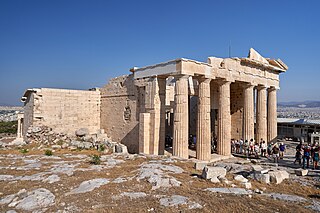
The Propylaia is the classical Greek Doric building complex that functioned as the monumental ceremonial gateway to the Acropolis of Athens. Built between 437 and 432 BCE as a part of the Periklean Building Program, it was the last in a series of gatehouses built on the citadel. Its architect was Mnesikles, his only known building. It is evident from traces left on the extant building that the plan for the Propylaia evolved considerably during its construction, and that the project was ultimately abandoned in an unfinished state.

The Temple of Roma and Augustus was a monopteral circular Ionic temple built on the Acropolis of Athens c. 19 BCE, likely coincident with Augustus' second visit to Athens. The structure was axially aligned with the eastern entrance of the Parthenon, placed 23 m (75 ft) eastward. The temple, which asserted the divinity of Rome and the Imperial cult in the context of the religious centre of the Acropolis, was a propaganda monument erected at a time of tension between Rome and Athens. Its ruins remain on the Acropolis.

The Library of Pantainos was a building in ancient Athens. It was located at the southeast end of the Agora of Athens, south of the Stoa of Attalus, on the left side of Panathenaion Street. It was built by the Athenian philosopher Titus Flavius Pantainos between 98 and 102 AD, during the reign of the Roman emperor Trajan. The library building was dedicated to Athena Archegetis, with Trajan himself and the people of Athens, according to an inscription on the lintel of the main entrance, which is preserved embedded in the late Roman wall,.

Eucles of Marathon was a leading Athenian statesman early in the reign of Augustus. He was responsible for the construction of the Roman Agora in Athens and was the male-line ancestor of the 2nd-century aristocrat, Herodes Atticus.

Pammenes of Marathon was a leading Athenian statesman early in the reign of Augustus. He was a key figure in the introduction of the imperial cult at Athens, overseeing the construction of the Temple of Roman and Augustus on the Acropolis and serving as Athens' first priest of Roma and Augustus. He was one of the three leading figures in Athens in the Augustan period, alongside Antipater of Phlya and Eucles of Marathon.

The Beulé Gate is a fortified gate, constructed in the Roman period, leading to the Propylaia of the Acropolis of Athens. It was constructed almost entirely from repurposed materials taken from the Choragic Monument of Nikias, a monument built in the fourth century BCE and demolished between the second and fourth centuries CE. The dedicatory inscription from Nikias's monument is still visible in the entablature of the Beulé Gate.

